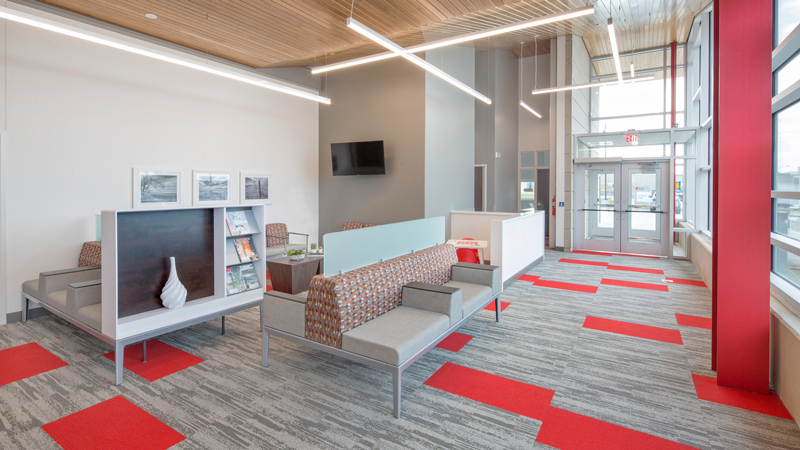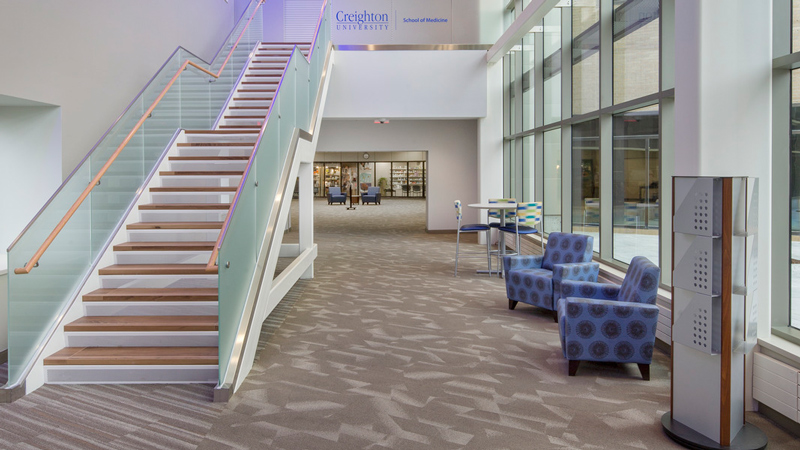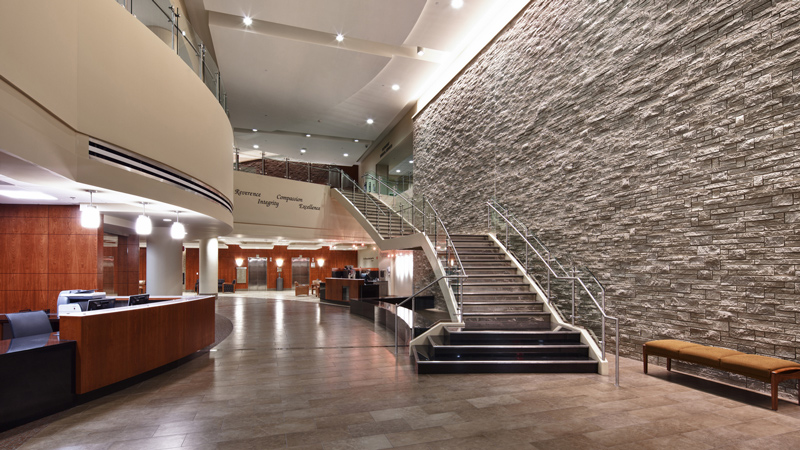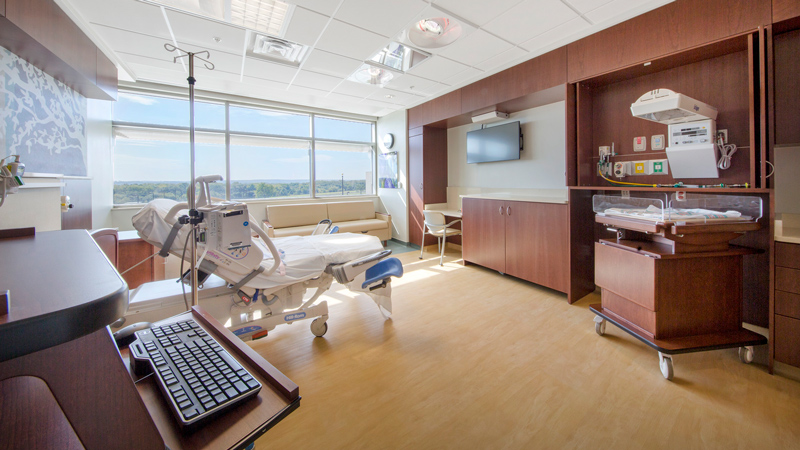Recent Articles
Healthcare flooring to wow and calm
In Medical Construction & Design, interior designers Jen Ankerson and Heather Robbins discuss how smart flooring choices can strengthen branding for healthcare providers

Excerpted from the article:
Consumerism is changing the business of healthcare, and brand loyalty is the holy grail. As patients take more control over their health spending, providers can influence buying decisions by offering a patient experience that is pleasant, convenient, and seamless across digital platforms and physical locations.
As retailers and hoteliers know, design is central to the customer experience. The way a space looks and feels creates an emotional response that sticks in your memory, creates positive associations, and ultimately influences the strength of a brand.
Flooring decisions, while always important in healthcare for practical reasons such as infection control, are now given added weight. Beyond initial cost, durability, maintenance, sustainability, noise, and wayfinding, flooring is now viewed as an integral part of a branded patient experience.
Inspired by trends in hospitality, residential, and retail design, the new wave of healthcare flooring is simple, naturalistic, comforting and even fun. Rather than seek to distract, today’s best flooring solutions fit together with strategic architectural and furnishing decisions to create memorable moments for patients and inspire brand loyalty.
Creating brand moments
In their 2017 book The Power of Moments, branding gurus Chip and Dan Heath share a powerful bit of insight about how customers experience brands:
“When we assess our experiences,” they write, “we don’t average our minute-by-minute sensations. Rather, we tend to remember flagship moments: the peaks, the pits and the transitions. This is a critical lesson for anyone in the service business, from restaurants to medical clinics.”

Flooring can assist in creating flagship moments in two main ways: it can pop, or it can go away to allow other elements of the design to take center stage.
Nebraska Medicine’s new primary-care clinic prototype is a great example of flooring creating a wow moment. In the lobby and staff spaces, bright red carpet tiles pop from the neutral gray background, giving the entry experience a sense of energy that is instantly memorable.
Throughout the clinic, red appears in different forms – in carpeting, upholstery, wall art, painted beams, and translucent dividers – creating total look and feel that embodies Nebraska Medicine’s motto of “Serious Medicine, Extraordinary Care.” By repeating this prototype scheme in four new clinics throughout the Omaha metro area, patients feel connected to a seamless care experience that capitalizes on experiential design.
The carpeting at Creighton University Medical Center’s new Bergan Mercy ambulatory clinic plays the opposite role of Nebraska Medicine’s wild red – blending into the background to allow pops of “Creighton blue” to speak. An abstract carpet pattern of taupe and gray complements wood-look ceiling tiles and stair treads, but mostly avoids attention. Meanwhile, blue acrylic clouds, furniture, signage and LED lighting contribute to an overall experience that reinforces patients’ associations to the university.
Whether blending into the background or grabbing attention, thoughtful flooring decisions are an important part of creating a distinctive patient experience, fitting together with other design elements to create a cohesive picture of the brand.
Making it like home
Patient comfort is a primary goal of every healthcare project, reducing the stress inherent in healthcare situations. As healthcare designers, we aim to create environments that are homelike, and often find ourselves inspired by trends in residential design.
Today’s home décor trends favor neutral grays, natural materials, and pops of color that can be easily changed as trends come and go without requiring a major overhaul. Browns are out, and lighter tones such as whitewashed wood-look LVT are in.
The beauty of neutral grays is that they allow the warmth of wood, the textures of stone, and the richness of saturated colors to shine, resulting in a layered, sophisticated aesthetic.

This layering of textures and materials is shown dramatically in KentuckyOne Health’s St. Joseph London hospital in London, Kentucky. A neutral porcelain tile floor in the hospital’s main entry sequence provides an elegant but understated foreground for a massive, double-height stone wall, which brings in the textures of nature. Dark wood in paneling and furniture is used sparingly to add warmth to the space, and create a memorable and comforting patient experience.
In patient rooms, where both comfort and infection control are high priorities, designers are always looking for products that meet high aesthetic standards while still offering a seamless, non-porous surface where germs can’t hide. In recent years, manufacturers have gotten better at achieving a convincing wood look in a sheet vinyl product.
The patient rooms at Irwin Army Community Hospital do a great job of balancing infection control and patient experience. Inspired by the natural beauty of the Kansas prairie, the pine-look sheet flooring brings in bright, blonde notes that makes the space fresh and clean. Wall treatments bring in tree-branch shapes, and large windows take advantage of strategic building siting to fill the room with natural light and allow views to untouched nature.
By employing the timeliness of current residential trends and the timelessness of nature, great flooring decisions become an integral part of a calm, pleasant patient experience.

Staying practical
Even as consumerism pushes healthcare flooring decisions into the realm of boutique design, it’s important to note that practicality still reigns supreme in healthcare.
Healthcare flooring takes a lot of abuse, its cleaning regimens are more intense, and its applications are generally so extensive that it’s important to go with manufacturers you can trust. No matter how dazzling the flooring is on day one, it’s important to think long-term about whether the manufacturer will still be able to deliver the same products down the road.
It’s also worth noting that a lot of interior design elements “ugly out” before they wear out. A color that’s fashionable today might be hopelessly dated next year. When choosing trendy colors for healthcare spaces, it’s best to use them in applications where they can be changed easily and cheaply. If you have to choose between a trendy floor offering a pop of color, or an accent wall that can be easily repainted, go with the accent wall. It’s much harder to replace flooring. When in doubt, it’s best to pick timeless, neutral flooring that will go with anything.
As healthcare systems become more sophisticated about how they brand themselves, there will continue to be new opportunities to create memorable moments for patients. Flooring is a big part of that, whether it’s function is to pop or fade into the background. By employing the tools of experiential design, interior designers can turn every touchpoint into a chance to engage with the brand and drive patient loyalty.
Download the article:
